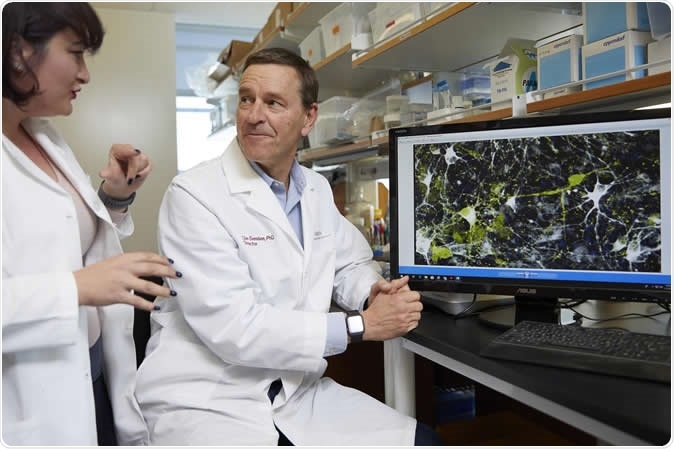A new study published in the journal Nature Medicine on January 2020 suggests that Parkinson’s disease developing before the age of 50 years could be due to an abnormality in certain brain cells that remains dormant until the age of onset of the disease. It also indicates the potential usefulness of a specific drug to prevent this by correcting the brain cell disorder.

Clive Svendsen, PhD, director of the Cedars-Sinai Board of Governors Regenerative Medicine Institute, right, and Nur Yucer, PhD, a project scientist, discuss a microscope image of dopamine neurons. Image Credit: Cedars-Sinai
What causes Parkinson’s disease?
Parkinson’s disease affects about 500,000 people in the US every year, and unfortunately this number is rising. In most cases the illness begins after the age of 60 years, but it can occur between 21 and 50 years in about a tenth of cases.
Parkinson’s disease is due to the impairment or loss of brain cells that make dopamine, a neurotransmitter that is involved in the coordination of voluntary muscle activity. The reason for this loss is not clear as of now. It is characterized by insidious but progressive muscle symptoms which include slowness of movements, muscle rigidity, tremors and a loss of balance. There is no cure for this condition.
The study of Parkinson’s disease is complicated by the fact that cells that are lost are impossible to study. As a result, research centered on the use of tissues taken from patients who have died, from experimental animals and from immortalized cell lines, which show how these tissues differ from those in healthy tissue. In this regard, the emerging field of iPSCs has opened up new possibilities to help researchers understand how cell changes cause Parkinson’s disease in humans.
The study
The current study focuses on the subset of Parkinson’s disease which starts earlier than 50 years. The researchers looked at induced pluripotent stem cells (iPSCs), which are a form of stem cell derived from mature or adult blood cells that are exposed to a program that “turns the cell clock backward”, restoring the primitive, undifferentiated or embryonic state of the cell. This means that the cell can now give rise to any of the numerous cell types in the human body, all of which will be genetically identical to the cells of the patient.
In this case, the mature cells were taken from patients with young-onset Parkinson’s disease. These were transformed into iPSCs which were then used to create dopaminergic neurons. The neurons formed from the stem cells of each patient were then cultured in a petri dish so that their function could be studied. This was in order to allow the scientists to see how the neurons might have operated from embryonic life onwards. Researcher Clive Svendsen says, “Our technique gave us a window back in time to see how well the dopamine neurons might have functioned from the very start of a patient's life.”
The findings
Analysis of the working of the neurons formed from the iPSCs showed that they differed from normal nerve cells in two ways:
- They were filled with a ‘waste’ protein called alpha-synuclein, that is typically found in most forms of Parkinson’s disease
- They contain poorly functioning lysosomes, which are bags of enzymes that collect unwanted materials from the cell and break them down to recycle useful parts and dispose of the rest. This type of malfunction is suspected to be possibly the reason for the accumulation of alpha-synuclein.
If so, these changes could be revealing, for the first time, the earliest changes that occur in young-onset Parkinson’s. Says Svendsen, “It appears that dopamine neurons in these individuals may continue to mishandle alpha-synuclein over a period of 20 or 30 years, causing Parkinson's symptoms to emerge.”
A potential solution
In addition, the iPSCs were also pressed into service to test the effects of several drugs on these abnormalities in the metabolism of the dopaminergic neuron. For instance, they found a drug named PEP005 that is currently FDA-approved for the treatment of precancerous conditions of the skin. This was found to reduce alpha-synuclein levels within dopamine neurons, in culture as well as in living mice.
Not only so, PEP005 also corrected the levels of activated protein kinase C, an enzyme found to be abnormally high in these patients, though what it does is currently unknown.
The future
The next step is to find out how this drug can be administered so as to evaluate whether it can be used to treat or to prevent young-onset Parkinson’s disease. Additionally, the researchers want to see if the brain cell abnormalities present in this form of Parkinson’s are shared by other forms as well.
According to study co-author Michele Tagliati, “Young-onset Parkinson's is especially heartbreaking because it strikes people at the prime of life. This exciting new research provides hope that one day we may be able to detect and take early action to prevent this disease in at-risk individuals.”
Journal reference:
Laperle, A.H., Sances, S., Yucer, N. et al. iPSC modeling of young-onset Parkinson’s disease reveals a molecular signature of disease and novel therapeutic candidates. Nat Med (2020). https://doi.org/10.1038/s41591-019-0739-1